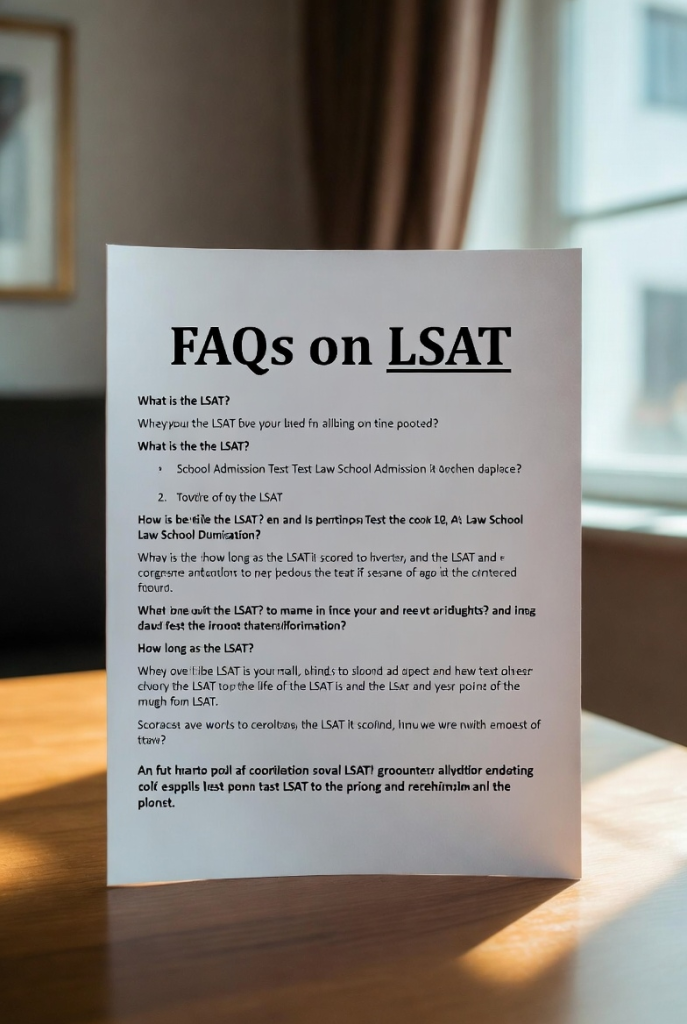
Introduction
The LSAT Writing section often gets overlooked by test-takers, yet it plays a vital role in demonstrating your ability to think, reason, and argue like a future lawyer. Unlike multiple-choice sections, this part of the LSAT requires you to craft a clear and logical argument — choosing one side of a given issue and defending it with sound reasoning. While it doesn’t contribute to your overall score, admissions committees review it to assess how well you communicate under pressure. Understanding the structure and purpose of this argumentative task is the first step toward writing an LSAT essay that stands out for its clarity, coherence, and persuasive strength.
What Is the LSAT Writing Section?
The LSAT Writing Section is a separate, online essay component of the Law School Admission Test designed to assess your ability to reason logically, think critically, and express ideas clearly in writing. You’re presented with a decision prompt — a short scenario outlining two positions, actions, or policies that both have merits and drawbacks. Your task is to choose one option and build a persuasive argument defending it.
There’s no “right” answer. What matters is how effectively you justify your choice using logical reasoning and relevant evidence from the prompt. Law schools receive your writing sample along with your LSAT score report, giving admissions committees insight into your communication style, argument structure, and analytical thinking.
Although the section is unscored, it’s an important opportunity to demonstrate that you can think like a lawyer — evaluating complex issues, weighing competing interests, and presenting a clear, well-organized case in writing.
Purpose of the LSAT Argumentative Writing Task
The purpose of the LSAT Argumentative Writing Task is to evaluate your ability to analyze information, make sound decisions, and defend a position logically — essential skills for success in law school and legal practice. Rather than testing your factual knowledge, it measures how you reason through competing arguments and present your ideas in a structured, persuasive manner.
In real-world legal work, attorneys often need to argue for one side of an issue even when both sides have valid points. The LSAT Writing task mirrors this reality by challenging you to choose between two equally defensible options and justify your choice with clear, evidence-based reasoning.
Through this exercise, admissions committees assess:
- Critical Thinking: How effectively you identify key factors and evaluate trade-offs.
- Analytical Reasoning: How logically you organize and connect your points.
- Written Communication: How clearly and professionally you express complex ideas.
Ultimately, the purpose of the LSAT writing task is to show that you can think like an advocate — presenting arguments that are balanced, coherent, and grounded in logic rather than emotion.
LSAT Argumentative Writing Structure

A well-organized LSAT essay follows a clear and logical structure that mirrors the way lawyers build their arguments. Your goal is to make your reasoning easy to follow while showing depth of analysis. The structure below, recommended by EssayAssits.com, helps you stay focused and persuasive throughout your response.
1. Introduction: Present Your Decision Clearly
Start with a brief, confident statement of which option you’ve chosen and why. This sets the tone for your argument and lets the reader know what to expect.
Example:
I recommend that the city expand its public transportation system rather than build more parking garages because it provides long-term environmental and economic benefits.
Keep your introduction short—two to three sentences are enough to state your position and preview your reasoning.
2. Body Paragraph 1: Present Your Strongest Reason
Lead with your most compelling argument. Use facts, logic, and evidence from the prompt to explain why your choice is the better option.
- Focus on one main idea.
- Use transition words like because, therefore, and as a result for logical flow.
Example:
Expanding public transportation will reduce traffic congestion and pollution, creating a healthier, more sustainable city environment.
3. Body Paragraph 2: Acknowledge the Alternative
A strong LSAT essay doesn’t ignore the opposing option. Briefly recognize its strengths, then explain why your choice remains superior overall.
Example:
While building new parking garages might offer short-term relief for commuters, it fails to address the city’s larger infrastructure and environmental challenges.
This shows evaluative thinking — a key skill law schools look for.
4. Conclusion: Reinforce Your Argument
End your essay by summarizing your reasoning and restating your decision. Avoid adding new ideas; instead, reinforce your position with a sense of finality.
Example:
In conclusion, investing in public transportation offers greater long-term benefits for the community, the environment, and the city’s economic future.
EssayAssits Tip:
Think of your LSAT writing like a courtroom argument — open strong, provide logical evidence, anticipate objections, and close confidently. A clear structure not only strengthens your argument but also shows that you can think and write like a legal professional.
Example LSAT Argumentative Writing Prompt

To help you understand how the LSAT Writing section works in practice, let’s look at a sample prompt and a model response. Remember, your task is to choose one of two reasonable options and defend it logically — not to find a “correct” answer.
Prompt:
A city has received funding to support one of two community improvement projects:
- Build a new sports complex to promote health, recreation, and tourism.
- Renovate the public library to expand learning opportunities and digital access.
Both projects would cost the same and bring value to the community, but only one can be completed.
Write an essay in which you argue for one project over the other.
Support your choice with logical reasoning and relevant evidence from the information provided.
Sample LSAT Argumentative Writing Response (Excerpt)
I recommend that the city renovate the public library rather than build a new sports complex because it offers broader, longer-lasting benefits for the community. A modernized library would provide educational resources, internet access, and community programs that serve residents of all ages and backgrounds.
While a sports complex would encourage physical fitness and attract visitors, its benefits would primarily target a narrower group — athletes and sports fans. In contrast, an updated library supports lifelong learning, career development, and digital literacy, which are crucial for long-term social and economic growth. Moreover, libraries often partner with schools and local organizations, extending their impact beyond recreation into education and empowerment.
For these reasons, renovating the public library is the better investment. It addresses both present and future needs by promoting equal access to information and fostering community engagement — outcomes that contribute more meaningfully to the city’s overall development.
EssayAssits Takeaway:
This example shows what LSAT evaluators want to see — a clear decision, logical reasoning, acknowledgment of the alternative, and a strong conclusion. Your essay doesn’t need fancy language; it needs clarity, structure, and persuasion.
EssayAssits Tips for LSAT Writing Success

Mastering the LSAT Writing section isn’t about being flashy or overly creative — it’s about being clear, logical, and organized. At EssayAssits.com, we believe that with the right strategy and structure, anyone can write a persuasive, law-school-ready argument. Here are our expert tips to help you stand out:
1. Focus on Reasoning, Not Emotion
Admissions officers want to see that you can make a rational, evidence-based argument. Avoid emotional appeals or exaggerated claims. Instead, rely on logic, clear examples, and well-structured points.
2. Take a Clear Stand
Don’t hedge or sit on the fence. Choose one side of the argument early and commit to it. A confident, well-supported stance demonstrates your ability to make decisive judgments — a core skill in law and policy.
3. Acknowledge the Other Side
Great arguments recognize opposing views. Briefly discuss the alternative option, but explain why your choice better addresses the situation. This shows balance and analytical maturity.
4. Stay Organized
Use clear paragraphs and transitions to make your essay easy to follow. Each paragraph should have one central idea supported by reasoning or evidence from the prompt.
5. Use Logical Connectors
Phrases like therefore, as a result, however, and in contrast guide readers through your reasoning and make your argument more cohesive.
6. Keep It Concise
You have limited time, so every sentence should serve a purpose. Avoid unnecessary words or repetition — clarity always outweighs length.
7. Practice Timed Writing
The LSAT Writing section is time-restricted, so simulate real conditions. Practice structuring your argument within 35 minutes to improve speed and focus.
8. Review Grammar and Tone
While minor errors won’t ruin your essay, clear and professional writing leaves a strong impression. Maintain a formal, academic tone that reflects your readiness for law school.
9. Use Examples Strategically
When possible, refer to evidence from the prompt to strengthen your points. This makes your reasoning feel grounded and realistic.
10. End Strong
Finish with a concise conclusion that reinforces your decision and main reasoning. Don’t add new points — just reaffirm your stance with confidence.
EssayAssits Final Tip:
Think of your LSAT essay as your first courtroom argument. You’re not just writing — you’re advocating. Each sentence should move your reader toward understanding why your choice makes the most logical sense. Focus on reasoning, structure, and clarity, and your LSAT writing sample will stand out for all the right reasons.
Final EssayAssits Thoughts
The LSAT Writing section may be unscored, but it’s far from unimportant. It’s your chance to demonstrate how you think, reason, and argue — core skills every future lawyer must master. A clear, well-structured essay tells law schools that you can handle complex issues, evaluate both sides fairly, and communicate persuasively under pressure.
At EssayAssits.com, we encourage test-takers to view this task as an opportunity, not an afterthought. The ability to craft a logical, balanced argument will serve you far beyond the LSAT — in your law school essays, professional writing, and real-world advocacy. Approach the LSAT Writing section with confidence, structure your ideas strategically, and let your reasoning skills speak for themselves.
Remember: great writing isn’t about fancy language — it’s about clarity, coherence, and conviction.
FAQs

1. Is the LSAT Writing section scored?
No. The LSAT Writing section is not scored, but your essay is sent to every law school that receives your LSAT results. Admissions officers use it to assess your reasoning and writing abilities.
2. How long is the LSAT Writing section?
You’ll have 35 minutes to plan, write, and proofread your essay. Time management is key — spend a few minutes outlining before you start writing.
3. What kind of topics appear in LSAT Writing prompts?
Prompts usually present a decision-making scenario, such as choosing between two policies, actions, or strategies. Each option has both strengths and weaknesses, allowing you to argue either side logically.
4. How long should my LSAT essay be?
There’s no strict word count, but a strong response typically falls between 300–500 words — long enough to develop your reasoning but concise enough to stay focused.
5. Can I prepare for LSAT Writing in advance?
Yes! Practice with sample prompts, study strong examples, and use EssayAssits’s recommended structure: Introduction – Body Paragraph 1 – Body Paragraph 2 – Conclusion. The more you practice, the more natural it becomes.
6. Do spelling or grammar mistakes matter?
Minor errors won’t harm your essay, but consistent mistakes or unclear writing can weaken your argument. Always aim for clarity, precision, and professionalism.
7. Can I complete the LSAT Writing after the main test?
Yes. The LSAT Writing is taken online, separately from the multiple-choice sections, and can be completed before or after your main LSAT test date.
8. What’s the best way to stand out in the LSAT Writing section?
Focus on logical structure, balanced reasoning, and clear communication. Avoid emotional appeals, use transitions effectively, and always acknowledge the opposing side before reinforcing your choice.
EssayAssits Tip:
Treat the LSAT Writing section like your first legal argument — concise, organized, and persuasive. Practice the EssayAssits way: think critically, write clearly, and argue confidently.
